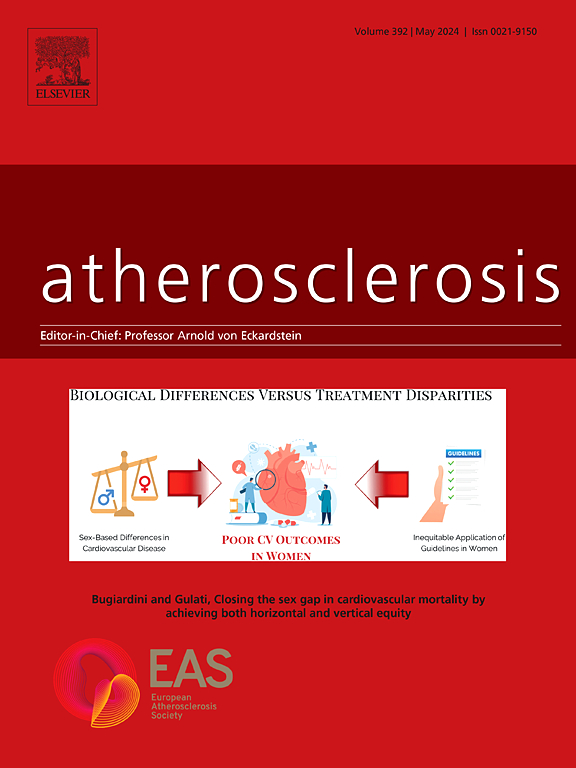Antiplatelet therapy with clopidogrel versus aspirin in atherosclerotic cardiovascular disease: a systematic review and meta-analysis
IF 5.7
2区 医学
Q1 CARDIAC & CARDIOVASCULAR SYSTEMS
引用次数: 0
Abstract
Background and aims
Whether single antiplatelet therapy (SAPT) with clopidogrel offers superior ischemic efficacy and a more favourable bleeding profile than aspirin in atherosclerotic cardiovascular disease is unclear.
Methods
A systematic search on the main databases Medline, Web of Science, and Embase until April 21, 2024 was performed. Only randomized trials were eligible for this analysis. As primary endpoint we analyzed major adverse cardiovascular events (MACE), defined as a composite of all-cause mortality, non-fatal myocardial infarction (MI) and non-fatal stroke. As secondary endpoints we investigated the individual primary endpoints as well as the rate of total and severe bleeding events. The analysis was carried out using the odds ratio (OR) as outcome measure. Due to the expected heterogeneity across studies, a random-effects model was fitted to the data.
Results
In total, 6 randomized trials comprising 33,508 patients (16,824 on clopidogrel, 16,684 on aspirin) were analyzed. Clopidogrel as compared to aspirin significantly reduced MACE (OR 0.85 [95 %CI 0.77–0.94], p < 0.001, I2 = 26 %). The reduction was driven by a decrease in non-fatal MI (OR 0.73 [95 %CI 0.60–0.90], p = 0.01, I2 = 28 %) and stroke (OR 0.86 [95 %CI 0.74–1.00], p = 0.05, I2 = 8 %), without increasing the rates of total (OR 1.04 [95 %CI 0.83–1.31], p = 0.73, I2 = 72 %) or severe bleeding (OR 0.89 [95 %CI 0.83–1.18], p = 0.43, I2 = 50 %). No effect on all-cause mortality was detectable (OR 0.96 [95 %CI 0.87–1.06], p = 0.41, I2 = 0 %).
Conclusion
In patients with atherosclerotic cardiovascular disease, SAPT with clopidogrel is associated with lower MACE rates as compared to aspirin without increasing the risk of bleeding.

氯吡格雷与阿司匹林抗血小板治疗动脉粥样硬化性心血管疾病:系统回顾和荟萃分析
背景和目的在动脉粥样硬化性心血管疾病中,氯吡格雷单次抗血小板治疗(SAPT)是否比阿司匹林具有更好的缺血性疗效和更有利的出血情况尚不清楚。方法系统检索截至2024年4月21日的主要数据库Medline、Web of Science和Embase。只有随机试验才符合此分析。作为主要终点,我们分析了主要不良心血管事件(MACE),定义为全因死亡率、非致死性心肌梗死(MI)和非致死性卒中的组合。作为次要终点,我们调查了个体主要终点以及总出血事件和严重出血事件的发生率。分析采用优势比(OR)作为结果测量。由于预期研究之间存在异质性,因此对数据拟合了随机效应模型。结果共分析6项随机试验33,508例患者,其中氯吡格雷组16,824例,阿司匹林组16,684例。与阿司匹林相比,氯吡格雷显著降低MACE (OR 0.85 [95% CI 0.77-0.94], p < 0.001, I2 = 26%)。减少的原因是非致死性心肌梗死(OR 0.73 [95% CI 0.60-0.90], p = 0.01, I2 = 28%)和卒中(OR 0.86 [95% CI 0.74-1.00], p = 0.05, I2 = 8%)的减少,而不增加总发生率(OR 1.04 [95% CI 0.83-1.31], p = 0.73, I2 = 72%)或严重出血(OR 0.89 [95% CI 0.83-1.18], p = 0.43, I2 = 50%)。未发现对全因死亡率有影响(OR 0.96 [95% CI 0.87-1.06], p = 0.41, I2 = 0%)。结论在动脉粥样硬化性心血管疾病患者中,与阿司匹林相比,SAPT联合氯吡格雷与较低的MACE发生率相关,且未增加出血风险。
本文章由计算机程序翻译,如有差异,请以英文原文为准。
求助全文
约1分钟内获得全文
求助全文
来源期刊

Atherosclerosis
医学-外周血管病
CiteScore
9.80
自引率
3.80%
发文量
1269
审稿时长
36 days
期刊介绍:
Atherosclerosis has an open access mirror journal Atherosclerosis: X, sharing the same aims and scope, editorial team, submission system and rigorous peer review.
Atherosclerosis brings together, from all sources, papers concerned with investigation on atherosclerosis, its risk factors and clinical manifestations. Atherosclerosis covers basic and translational, clinical and population research approaches to arterial and vascular biology and disease, as well as their risk factors including: disturbances of lipid and lipoprotein metabolism, diabetes and hypertension, thrombosis, and inflammation. The Editors are interested in original or review papers dealing with the pathogenesis, environmental, genetic and epigenetic basis, diagnosis or treatment of atherosclerosis and related diseases as well as their risk factors.
 求助内容:
求助内容: 应助结果提醒方式:
应助结果提醒方式:


